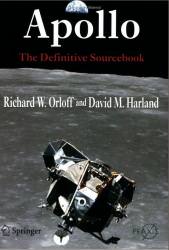 Our Moon has been visited by men, yet this fact may seem like fiction to many people. Over an incredibly short span, people of one nation came together, developed a technology and achieved the goal of walking on the lunar surface. For those wanting a reference for this momentous event, Richard Orloff and David Harland provide their book, Apollo – The Definitive Sourcebook. In it are the facts and figures regarding the events surrounding the people and hardware of this amazing achievement.
Our Moon has been visited by men, yet this fact may seem like fiction to many people. Over an incredibly short span, people of one nation came together, developed a technology and achieved the goal of walking on the lunar surface. For those wanting a reference for this momentous event, Richard Orloff and David Harland provide their book, Apollo – The Definitive Sourcebook. In it are the facts and figures regarding the events surrounding the people and hardware of this amazing achievement.
This book, being a source book, sets out the facts of the Apollo program. Opinion isn’t present, nor is there much background information. However, there is a large quantity of numbers, tables and straightforward descriptions. Through a basically chronological sequence, the authors advance the readers through the inception and utilization of the vehicles of the program and the results of the lunar landings.
The book commences with a long chapter that describes the early program management. The start is with the failed launch of the Vanguard project during the International Geophysical Year. However, there is no discussion on the emotions of the time. Rather, it immediately jumps to the Redstone missile and the staged launch of the Explorer satellite. By the third page it’s discussing the development of a ‘manned’ satellite, the precursor to the Apollo program. The authors instill an undertone of a desire to put people into space that, however, lacked a mandate. Eventually the mandate appeared with the provision of full government support via the granting of the highest national priority rating for procurement. Thus, with an objective and funding, the book shows how the program quickly meshed technical capability with mission requirements into a workable system.
With the completion of the somewhat lengthy first chapter on program development, the authors provide a chapter by chapter detailing of each of the main Saturn launches. It starts with the SA-1 first flight test, continues on through the AS-20x series and concludes with each of the manned AS-20x series rocket launches. These chapters come in necessarily repetitive sections of background, lunar landing site (if applicable), launch preparations, flight phases and recovery. These sections are dry and terse, with many lists of mission events corroborated against time. With lots of information presented, these sections are the bread and butter of the book. At the end of each chapter, text provides conclusions and objectives that demonstrate the value added. As well, chapters finish with a brief selection of relevant black and white photographs. From these, the reader has an excellent ready referral to each of the Apollo missions.
This book is aptly named, as it is a well presented source book for the Apollo space program. The first chapter on program development is a little convoluted and it may be difficult to recover information quickly. However, the following chapters, with their repetitive sections, make for easy recovery of what happened and when. For example, each has the atmospheric conditions; the temperature, air pressure and wind speed, for each of the launches. However, the reader will likely be going elsewhere to learn more of why, such as why a given design decision was made, as this book is all about facts.
In an unexpected and interesting aside, the authors include a detailed description of the results of the lunar exploration for each mission. There are descriptions of land formations; the massifs, breccia and ejecta, together with thoughts about the Moon’s original formation and the means of landscape. Though this is not about the Apollo missions, it is a direct result of the missions and is applicable.
This book is ideal for readers who want a ready reference on the events and timelines of the Apollo missions. Details regarding speeds, orbits and landing locations fill the pages. Problems, as with Apollo 13, are without emotion or opinion. This leaves the reader unaware of the extent of the crisis but aware of the ‘non-nominal’ operations. Further, the book is focussed solely on the Apollo program. There is little information of other missions or rockets. Thus, in all, the reader can quickly and easily find Apollo mission details, as desired.
The Apollo Moon missions are a watershed for humanity. With them, humankind proved they could leave planet Earth, survive an alien environment and return with greater knowledge and understanding. Richard Orloff and David Harland set forth the events of this amazing time in their book Apollo- The Definitive Sourcebook. The compilation of events and activities clearly demonstrate the greatness of our advance.
Read more reviews, or purchase a copy online from Amazon.com.
Written by Mark Mortimer
